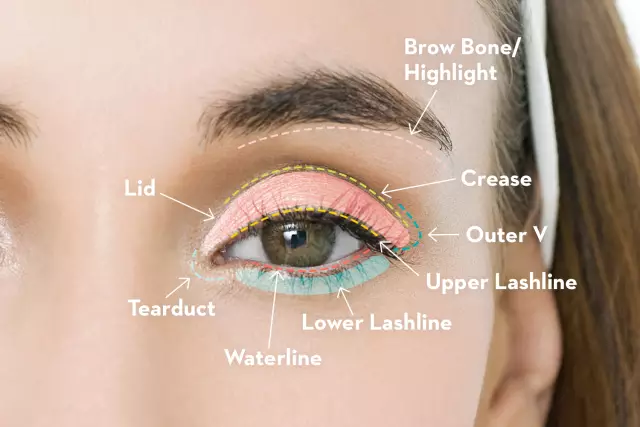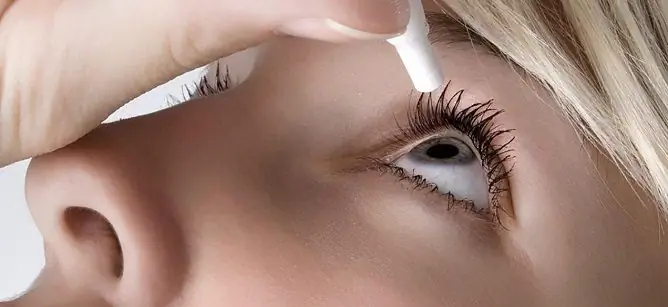- Author Rachel Wainwright [email protected].
- Public 2023-12-15 07:39.
- Last modified 2025-11-02 20:14.
Polynadim
Polynadim: instructions for use and reviews
- 1. Release form and composition
- 2. Pharmacological properties
- 3. Indications for use
- 4. Contraindications
- 5. Instructions for use a: scab and dosage
- 6. Side effects
- 7. Overdose
- 8. Special instructions
- 9. Application during pregnancy and lactation
- 10. Use in childhood
- 11. Use in the elderly
- 12. Drug interactions
- 13. Analogs
- 14. Terms and conditions of storage
- 15. Terms of dispensing from pharmacies
- 16. Reviews
- 17. Price in pharmacies
Latin name: Polynadim
ATX code: S01GA51
Active ingredient: diphenhydramine (diphenhydramine) + naphazoline (naphazoline)
Producer: Sintez, JSC (Russia)
Description and photo update: 2018-21-11
Prices in pharmacies: from 32 rubles.
Buy

Polynadim is a local combined drug with a vasoconstrictor and antiallergic effect, used in ophthalmology.
Release form and composition
Dosage form Polynadim - eye drops: transparent, slightly colored (in a cardboard box 1 or 50 plastic bottles with a nozzle-dispenser of 5 or 10 ml).
Composition for 1 ml drops:
- active substances: diphenhydramine - 1 mg; naphazoline - 0.25 mg;
- auxiliary components: boric acid - 15 mg; sodium tetraborate 10-aqueous (sodium tetraborate decahydrate) - 0.5 mg; edetate disodium - 0.6 mg; water-soluble methylcellulose - 1.5 mg; water for injection - up to 1 ml.
Pharmacological properties
Pharmacodynamics
Polynadim is one of the topical combined drugs used in ophthalmology.
Properties of active ingredients:
- diphenhydramine: has antiallergic effect, is a blocker of histamine H1 receptors; helps to reduce edema, itching, lacrimation;
- naphazoline: leads to prolonged vasoconstriction, is an alpha-adrenergic agonist; when applied topically due to the vasoconstrictor effect, it has a decongestant effect.
Indications for use
- acute allergic conjunctivitis, including pollinosis;
- conjunctivitis on the background of drug allergies;
- infectious eye diseases occurring with an acute allergic component (as an additional remedy).
Contraindications
Absolute:
- angle-closure glaucoma;
- conjunctival xerosis (keratoconjunctivitis dry, Sjogren's syndrome);
- combination therapy with monoamine oxidase inhibitors and for 10 days after their cancellation;
- pregnancy and the period of breastfeeding;
- age up to 2 years;
- individual intolerance to the components of the drug.
Relative (Polynadim is prescribed under medical supervision):
- arterial hypertension;
- thyrotoxicosis;
- arrhythmia;
- atherosclerosis;
- bronchial asthma;
- chronic rhinitis;
- adrenal adenoma;
- benign prostatic hyperplasia, occurring with the presence of residual urine;
- elderly age.
Instructions for use of Polynadim: method and dosage
Polynadim eye drops are intended for instillation into the conjunctival sac.
Recommended dosage regimen:
- adults: in case of acute symptoms every 3 hours, 1 drop, after a decrease in the severity of symptoms (decrease in irritation and swelling of the eyes), the frequency of use is reduced to 2-3 times a day. The drug is used until the disappearance of clinical symptoms;
- children from 2 years old: 1-2 drops per day.
According to the instructions, Polynadim can be used in a course of up to 5 days. Longer treatment should be discussed with your doctor.
If symptoms persist for more than three days, the drug is discontinued.
Side effects
- systemic reactions: rarely (especially in children and elderly patients) - drowsiness, tachycardia, tremors, pallor of the skin, pain in the heart, increased blood pressure, dizziness, increased sweating, agitation, headache, nausea;
- local reactions: symptoms of conjunctival irritation (in the form of burning in the eye area, conjunctival hyperemia, itching), eye pain, blurred vision, increased intraocular pressure, dryness of the nasal mucosa, mydriasis (after the abolition of Polynadim these disorders disappear); in isolated cases - transient corneal opacity (observed when using the drug at least 10 times a day for 7 days).
Overdose
If the recommended dosage regimen is observed, the development of an overdose is unlikely.
In children under 6 years of age, with frequent / long-term use, the following symptoms of systemic overdose may occur: tachycardia, prolonged mydriasis, depression of the central nervous system, hypothermia, increased blood pressure.
Therapy: symptomatic.
special instructions
Polynadim eye drops should not be used more often than once every 3 hours, the total duration of the course should not exceed 5 days.
When symptoms appear that indicate systemic absorption of the drug, the cancellation of therapy is required.
It is not recommended to use soft contact lenses for allergies. If it is impossible to avoid use, they should be removed before instillation of the drug. They can be installed back no earlier than 15 minutes later.
Influence on the ability to drive vehicles and complex mechanisms
Immediately after installation, there is a temporary impairment of vision clarity, and therefore, one should refrain from driving until it is restored.
Application during pregnancy and lactation
Polynadim is not prescribed during pregnancy / lactation.
Pediatric use
Children under 2 years old are not prescribed Polynadim.
Use in the elderly
Polynadym therapy in elderly patients should be carried out under medical supervision.
Drug interactions
When combined with tricyclic antidepressants, the vasoconstrictor effect of naphazoline may increase.
The combined use of naphazoline with monoamine oxidase inhibitors, as well as therapy with Polynadim for 10 days after their cancellation, can cause the development of a hypertensive crisis.
Analogs
Polynadim's analogs are: Betadrin, SIGIDA duo, Sanorin-Anallergin, Oftofenazole, etc.
Terms and conditions of storage
Store in a place protected from light at a temperature of 15-25 ° C. Keep out of the reach of children.
Shelf life is 2 years.
After opening the package, Polynadim can be used for 30 days.
Terms of dispensing from pharmacies
Available without a prescription.
Reviews about Polynadim
Reviews about Polynadim are mostly positive. It is noted that this is an inexpensive drug that has a quick effect - relieves irritation, tearing, redness and itching of the eyes. It is used for allergies and eye fatigue. Of the shortcomings, they point to the short shelf life of the drops after opening the package and the development, in some cases, of burning eyes.
The price of Polynadim in pharmacies
The approximate price for Polynadim eye drops for 1 bottle / dropper bottle (10 ml) is 25-30 rubles.
Polynadim: prices in online pharmacies
|
Drug name Price Pharmacy |
|
Polynadim eye drops 10 ml 1 pc. 32 RUB Buy |

Anna Kozlova Medical journalist About the author
Education: Rostov State Medical University, specialty "General Medicine".
Information about the drug is generalized, provided for informational purposes only and does not replace the official instructions. Self-medication is hazardous to health!






